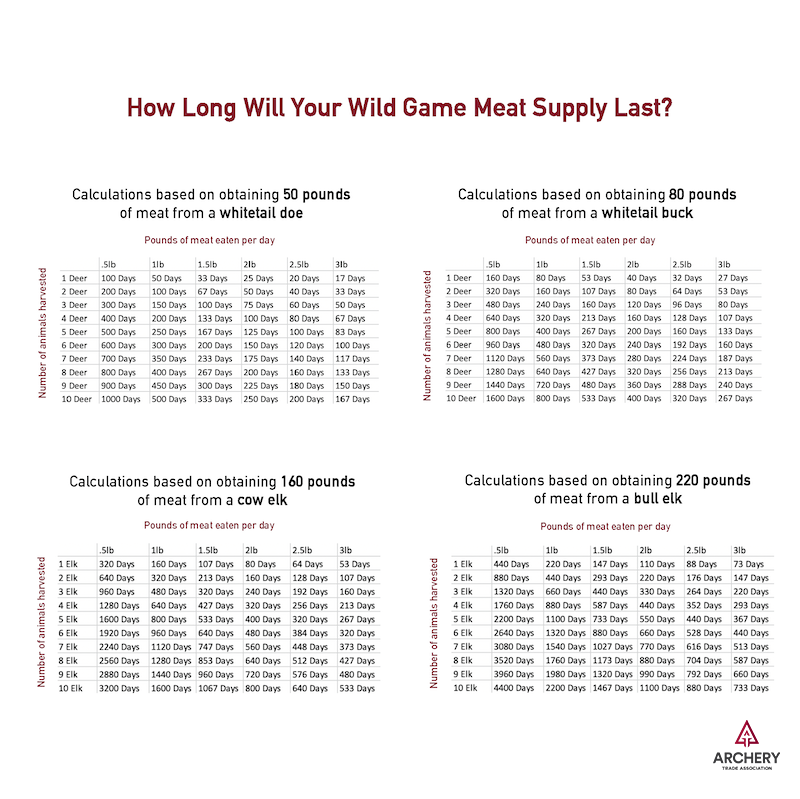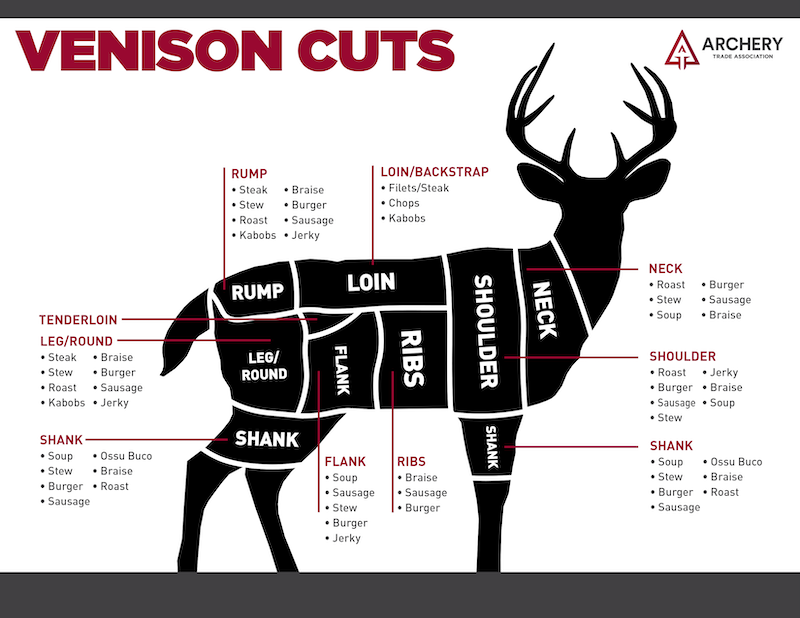Eating nothing but wild game year-round is realistic, but you must work hard and hunt often to keep your freezer full.
Wild-game animals provide lean, organic, hormone-free meat. Hunters who source and process their meat know its origins and how it was handled before they cooked and ate it. That history, coupled with each hunt’s unique story, makes game meat especially valuable.
Plus, it’s delicious. That’s why so many hunters strive not to buy domestic meats. They focus on harvesting and eating wild game exclusively, and you can, too.
Danielle Prewett, MeatEater’s wild foods contributing editor, and her husband began living off the land in 2013. They supplemented their diet with sandwich meat for a few years, and then transitioned to almost 100% wild game, except for locally sourced pork fatback and sausage casings.
Bowhunting 360 Facebook followers often ask, “How much deer or elk do I need to live solely off wild game?” The answer depends on how many people you need to feed, their ages and appetites, how often you travel or eat at restaurants, the size of animals you harvest, and how often you feed guests.

This chart explains how long your meat will last based on the game and the amount of meat. Photo Credit: ATA
Bowhunting 360 calculated how long meat from a deer or elk would last, based on how many pounds of meat your household consumes daily. The first chart assumes you got 50 pounds of venison from a white-tailed doe. The second chart assumes you harvested 80 pounds of venison from a white-tailed buck. The third chart renders 160 pounds of meat from a cow elk, and the fourth chart renders 220 pounds from a bull elk.
Therefore, if you’re a bachelor who eats a half-pound of venison daily (let’s say quarter-pound burgers for lunch and dinner), a doe would last 100 days, a buck 160 days, a cow elk 320 days, and a bulk elk 440 days. That means you’d need 3.65 does, 2.28 bucks, 1.14 cow elk, and less than one bulk elk to feed yourself 365 days.
If you have more mouths to feed, you must arrow more animals. Estimate how much meat your family would eat daily, and then consult the charts to determine how many deer or elk you need for a year-round venison supply.

This chart shows the different cuts of venison and how you can use them in your meals. Photo Credit: ATA
Supplementing your venison with other wild game adds variety to your meals, and makes your deer or elk last longer. You can also add ingredients to those meats to make them go further.
The Prewetts, for example, harvested two whitetails, one antelope, one turkey, one wild hog, and several rabbits, squirrels, geese, ducks, quail and redfish in 2019. In the past, they’ve also lived off one deer a long time by eating it nose-to-tail, meaning they cooked every part of it.
Prewett feels fortunate she can hunt and fish for all her protein, but knows not everyone can live that way. She suggests finding a balance for you and your family, and deliberately deciding what you’ll consume. If your hunts aren’t productive enough, and you decide to supplement your meat supply, she recommends buying sustainably raised meat from local sources.
That’s what Christine Thomas, another wild-game enthusiast, does each year. Thomas is the dean and a professor at the College of Natural Resources at the University of Wisconsin-Stevens Point. Thomas and her son-in-law try to harvest one or two deer and turkeys each year, and at least 30 pheasants, to sustain their family of four. But they also love beef and pork, so they usually buy a steer or hog each year, too.
No matter how you obtain your meat, consider these four factors if you want to eat wild game year-round:

Hunt other wild animals like hogs to stock your freezer. Photo Credit: Wide Open Spaces
Every ounce of wild-game meat you acquire takes more effort than any meat you buy.
“Hunting and foraging for food is much more time-consuming than going to the supermarket,” Thomas said. “You’ll also spend more time getting it ready to store.”
Prewett agrees. “If you want to live off wild game, be prepared to hustle,” she said. “We hunt and fish year-round. Filling the freezer is a full-time job.”
Scout and practice often to boost your chances of success, and then hunt hard.
State wildlife agencies set bag limits on game animals. If you need to eat more of a particular species than your state lets you shoot, consider your options.
– Diversify your wild-game options. In addition to hunting deer, consider gearing up for elk, bears, waterfowl, wild hogs, squirrels and rabbits. Prewett supplements her freezer with a variety of critters to stockpile meat and spend more time outdoors. Check your state’s regulations for season dates and bag limits for several game species.
– Recruit more participants. An easy way to double the meat entering your home is to recruit a family member to hunt with you. If you’re worried you’ll overhunt an area, hunt public lands, ask farmers for hunting access, and apply for special hunts.
– Hunt out of state. Extend your hunting season and buy more tags by hunting other states. Study your options and plan annual road trips.
If you harvest lots of game meat, you must learn to package and store it for year-round feasts. You can also dry, can, cure, smoke and freeze it. Prewett and Thomas freeze their meat after vacuum-sealing it. You can also use zip-style freezer bags, or wrap it in freezer paper. Bowhunting 360 discussed each method in the article “Freeze it! How to Save and Store Venison.” If necessary, buy a chest freezer so you have enough space to store your supply.
Label your packages with the date, cut of meat, and harvest location. Always read the labels to ensure you eat the oldest meats first to avoid freezer burn, which ruins the meat’s taste, looks and texture.
When finding meat that’s been frozen over a year, Thomas thaws and cans it to extend its shelf life. If you find yourself with too much meat, you can also donate or share some before filling your freezer.
To avoid making the same recipes often, Prewett and Thomas try to be creative in the kitchen.
“You can use venison in any recipe that calls for beef,” Thomas said. “If you have a pasta recipe you love with beef, just use wild game. But don’t treat venison or wild turkey like beef or chicken. Embrace their differences, and be patient as you get used to cooking it.”
A variety of wild game lets you easily diversify your meals. But if you have nothing except venison, keep trying different recipes and strategies.
Thomas suggests buying wild-game cookbooks, and Prewett likes using wild game in Thai, Vietnamese, Korean and South American recipes. You can also make jerky, sausage or other specialty meats. Visit Bowhunting 360’s “Wild Meat” webpage to find several amazing recipes and cooking methods.
Living on wild game requires time and work, but it’s healthy and rewarding for you, and good for the environments you hunt.